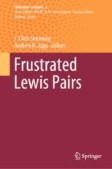Search
Search Results
-
A nucleophilic beryllyl complex via metathesis at [Be–Be]2+
Owing to its high toxicity, the chemistry of element number four, beryllium, is poorly understood. However, as the lightest elements provide the...

-

-
Three-arms PLA/PS copolymer based on 2,5-dihydroxy-1,4-benzoquinone
This study focuses on the preparation of hybrid block copolymers of polylactide (PLA) and polystyrene (PS) involving 2,5-dihydroxy-1,4-benzoquinone...

-
FLP-Mediated C–H-Activation
The C–H functionalization of aromatic molecules is a green approach that allows creating complex molecules from simple reagents. While these...
-
Boron-containing small rings: synthesis, properties, and application prospects
The studies published over the last 15 years on the synthesis, physicochemical properties, and application prospects of saturated and unsaturated...
-
Lewis Acidic Boranes in Frustrated Lewis Pair Chemistry
From their inception, boron-based frustrated Lewis pairsFrustrated Lewis pair (FLP) have garnered significant scientific attention thanks to the...
-
Highly reactive polyisobutylene through cationic polymerization of isobutylene
Highly reactive polyisobutylene (HRPIB) is the most important industrial polymeric material used as additives for lubricants, fuels and polymers....

-
Quantum Chemical Study of X@BikPbm, BikPbm∙X, X@SbkSnm, and SbkSnm∙X Clusters
AbstractClusters ( I h )-(Cd, Hg, Yb)@(Pb 12 , Sn 12 ), ( C 5 v )-(Ag, Au)@BiPb 11 , ( C 5 v )-Ag@SbSn 11 , ( D 5 d )(Ni, Pd, Pt)@Bi 2 Pb 10 , ( D 5 d )-Pd@Sb 2 Sn 10 , ( C 3 v )-(Pb 12 , Sn...

-
The Lewis electron-pair bonding model: the physical background, one century later
The shared electron-pair bonding model was suggested by Gilbert Lewis more than 100 years ago. Emerging from the chemical experience of the time,...

-
Redox-Active Guanidines and Guanidinate-Substituted Diboranes
Guanidino groups and guanidinate substituents are used to stabilise positive charges, both through mesomeric and through inductive effects. The...
-
Interplay of thermochemistry and Structural Chemistry, the journal (volume 27, 2016, issues 3–4) and the discipline
The contents of issues 3 and 4 of Structural Chemistry from the calendar year 2016 are summarized in the present review. A brief thermochemical...
-
Magnetically nano core–shell Fe3O4@Cu(OH)x: a highly efficient and reusable catalyst for rapid and green reduction of nitro compounds
Magnetically separable nano core–shell Fe 3 O 4 @Cu(OH) x with 22 % Cu content was prepared by the addition of sodium hydroxide to a mixture of CuCl 2 ·2H 2 O...

-
Rules of Aromaticity
The concept of aromaticity is elusive; it is not directly observable. Somewhat surprisingly, given the fuzzy character of this concept, there exist a...
-
Deviation from the anti-Markovnikov rule: a computational study of the regio- and stereoselectivity of diene hydroboration reactions
Hydroboration and subsequent use of boron compounds in novel organic synthesis have been fl ourishing in recent years largely due to its amiability...
-
Guanidine Metal Complexes for Bioinorganic Chemistry and Polymerisation Catalysis
Guanidines are highly useful ligands which have conquered coordination chemistry within the last 20 years. Their CN3 moiety allows multiple...
-
Catalysis in service of main group chemistry offers a versatile approach to p-block molecules and materials
Catalytic reactions that enable the formation of new bonds to carbon centres play a pervasive role in the state-of-the-art synthesis of organic...

-
Catalytic C–CN Bond Activation
Synthetic organic reactions through C–CN activation by transition metal catalysis are reviewed. C–CN bond activation by metal complexes proceeds...
-
Recent Advances in Synthesis of P-BH3 Compounds
This chapter is dedicated to the main achievements since 2007 regarding the synthesis of BH3-phosphorus complexes. Among this class of compounds,...
-
In silico studies toward the recognition of fluoride ion by novel bicyclic diborane receptors and tuning through remote substituent effects
Derivatives of 5,6-diborylbicyclo[2.1.1]hexane have been presented as the novel bicyclic diborane receptors for the recognition of fluoride ion. The...

-
Stereospecific synthesis of endo-endo-3,7-dioxabicyclo[3.3.0]octane lignans using 1,6-bis(dipropylboryl)-2,4-hexadiene
A general methodology for the stereoselective synthesis of compounds of the 2,6-diaryl-3,7-dioxabicyclo[3.3.0]octane series was developed. The...
